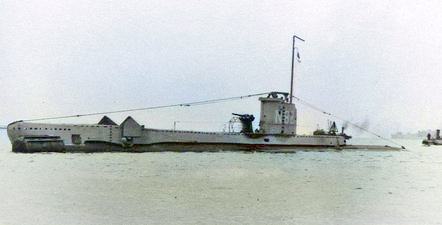Retrieved from the old ForumHMS Umpire was a 'U' Class small patrol submarine built at Chatham during WW2, one of 49 vessels of that class. Umpire and her sister submarine Una were unusual in that they were the only two submarines of that class not built by Vickers, with both boats being Chatham-built.
These were small submarines even by the standards of the day, being a quarter of the size of the Ocelot. They displaced 540 tons standard and 630 tons full load on the surfaced and 730 tond dived. They were armed with 4 21 inch torpedo tubes and carried 2 reloads per tube. They were also armed with a 3 inch deck gun.
HMS Umpire:

The U Class Submarine:

HMS Umpire was laid down on No7 slip on 1st January 1940 and was launched into the Medway on 30th December that year. She fitted out at Chatham and was commissioned on 10th July 1941.
Ordered to join 3rd Submarine Flotilla at Dunoon with the intention of working up in the North Sea before going to join the war in the Mediterranean. After leaving Chatham, she stopped overnight at Sheerness before joining a convoy headed north. Whilst underway on the surface, she suffered a failure in one of her diesel engines. This should not have been a problem as the submarine was diesel-electric. her diesel engines had no mechanical link to the propellers; they drove generators which supplied her electric motors. Unfortunately, her battery capacity wasn't sufficient to enable her to keep up with the convoy on only one generator, so her Commanding Officer, Lieutenant Mervyn Wingfield ordered a reduction in speed.
The submarine then encountered a south-bound convoy at about midnight on 19th July, while 12 miles off Blakeney, Norfolk. Instead of passing port-to-port, as per the 'rules of the road', they passed starboard-to-starboard. None of the vessels were showing any lights because of the risk of attack from German E-Boats. One of the vessels escorting the south-bound convoy, the armed trawler Peter Hendricks, collided with the Umpire in the darkness and caused the submarine to sink in 18 metres of water.
Of the 38 men aboard the Umpire, 22 were lost. One of the survivors was an officer called Edward Young. He was the first RNVR officer to qualify for the Submarine Service and had been promoted to Lieutenant on joining the Umpire at Chatham in March 1941. He was not on duty at the time of the collision and found himself in a flooding boat trapped on the bottom of the North Sea in 80 feet of water. After trying unsuccessfully to surface the boat using compressed air and searching the boat for more survivors, Young escaped with the Boat's First Lieutenant, an Engine Room Artificer and an Able Seaman through the Conning Tower. Unfortunately, only Young survived the escape attempt. The rest of the survivors had escaped through the Engine Room hatch, or like the vessels commander, had been on the bridge when to collision occurred.
Edward Young went on to be a decorated war hero, winning the DSO and the DSC (twice) and rising to the rank of Commander. He also went on to command the submarines P555 (becoming the first RNVR officer to command a submarine) and HMS Storm. Edward Young's exploits - including the short career of HMS Umpire and the details of her loss - are detailed in his autobiographical book 'One of Our Submarines' (ISBN 0-583-13531-5).